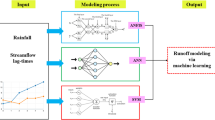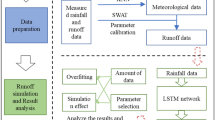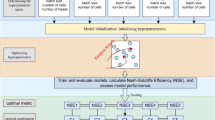Abstract
This study proposes a novel hybrid LSTM-SWMM model that integrates the advantages of the SWMM model and the LSTM neural network for the first time. The aim is to build an efficient and rapid model that considers the physical mechanism, in order to effectively simulate urban floods. The results indicate a good agreement between the simulated discharge process of the LSTM-SWMM model and the observed discharge process during the training and testing periods, reflecting the actual rainfall runoff process. The \({R}^{2}\) of the LSTM-SWMM model is 0.969, while the \({R}^{2}\) of the LSTM model is 0.954. Additionally, for a forecasting period of 1, the \(NSE\) value of the LSTM-SWMM model is 0.967, representing the highest forecasting accuracy. However, for a forecasting period of 6, the \(NSE\) value of the LSTM-SWMM model decreases to 0.939, indicating lower accuracy. As the forecasting period increases, the \(NSE\) values consistently decrease, leading to a gradual decrease in accuracy.








Similar content being viewed by others
Availability of Data and Material
Not applicable. The data in this manuscript is also used in other ongoing research, so data and materials are not applicable.
References
Abbasizadeh H, Nazif S, Hosseini SA, Hosseini SA, Tavakolifar H (2017) Development of a Coupled Model for Simulation of Urban Drainage Process Based on Cellular Automata Approach. Irrig Drain 67 (2):269–281
Cai QW, Chen ZH, Chen X, Chen XZ, Zhang DR (2017) Urban stormwater control effect simulation of low impact development measures. Water Resour Protect 33 (02):31–36
Cheng YC, Wang J, Li MH (2016) Some Problems in Runoff Yield Excess Calculation Based on Horton Infiltration Formula. Hydrology 36 (5):14–16
Cui Z, Guo SL, Wang J, Wang HY, Yin JB, Ba HH (2022a) Research on flood forecasting based on GR4J-LSTM hybrid model. People’s Yangtze River 53 (7):1–7
Cui Z, Zhou YH, Guo SL, Wang J, Ba HH, He SK (2021) A novel hybrid XAJ-LSTM model for multi-step-ahead flood forecasting. Hydrol Res 52 (6):1436
Cui ZJ, Qing XX, Yang SX (2022b) Prediction of urban rainfall runoff based on DM-LSTM. China Water Drainage 38 (19):132–138
Deng PD (2014) Study on peak runoff coefficient method and Mathematical model method for urban Stormwater channel design. Water Supply Drainage 50 (5):108–112
Dong WJ, Yang ZS (2002) Research and calculation method of inverse problem of one-dimensional Saint-Venant Equation. J Hydraul Eng 09:61–65
Feng J, Pan F (2018) A combined LSTM-BP multi-model hydrological forecast method. Computer and Modernization (07):82–85+92
Feng P, Cui GT, Zhong Y (2001) Evaluation and prediction of direct economic loss of urban flood disaster. J Hydraul Eng 08:64–68
Hou JM, Dong MJ, Li DL, Ma Yue, Ji GQ, Zhang S (2023) Drainage effect of urban drainage-pipe network under extreme rainstorms - taking Fengxi New City in Xi’an city, China as an example. J Earth Sci Environ 45(2):427–436
Hu CH, Du X, Zhao YZ, He JX, Liu GH, Chen L (2019) Study on the principle of Determining spatial scale of SWMM model in Plain Area: A case study of Zhengzhou City. Zhujiang People 40 (12):18–24
Jackson EK, Roberts W, Nelsen B, Williams GP, Nelson EJ, Ames DP (2019) Introductory overview: Error metrics for hydrologic modelling - A review of common practices and an open source library to facilitate use and adoption. Environ Model Softw 119:32–48
Li D, Jian SQ, Wang HL, Hu CH (2017) Research on rainstorm flood simulation based on SWMM model - take the new campus of Zhengzhou University as an example. China Rural Water and Hydropower (10):179–182, 193
Li ZC, Zhang YW, Wu Q, Hu CH (2022) Study on flood forecasting ensemble correction based on hierarchical optimization and LSTM. Water Resour Hydropower Eng 53(8):41–49
Liu CS, Wu Q, Hu CH, Yao YC, Xu YH, Chen YQ (2022) Study on Simulation and Optimization of the Sponge-City Hydrological Process Based on SWMM Model. Meteorol Environ Sci 45 (6):59–66
Liu HP, Dai PL (2007) Climatic characteristics of heavy rainfall in Zhengzhou. Meteorol Environ Sci 30:45–47
Ma BY, Wu ZN, Hu CH, Wang HL, Xu HS, Yan DH, Shan-e-hyder S (2022) Process-oriented SWMM real-time correction and urban flood dynamic simulation. J Hydrol 605:12
Ma ZJ (1998) Meteorological Floods and Marine Disasters in China. Hunan People’s Publishing House, Changsha
Nash JE, Sutcliffe JV(1970) River flow forecasting through conceptual models part I — A discussion of principles. J Hydrol 10(3):282–290
Pérez-Alarcón A, Garcia-Cortes D, Fernández-Alvarez JC, Martínez-González Y (2022) Improving monthly rainfall forecast in a watershed by combining neural networks and autoregressive models. Environ Process 9 (3):1–26
Ran MY (2000) Discussion on the hydrological effects of urbanization. J Sichuan Normal Univ 23 (7):436–439
Tao SM, Liang ZM, Chen ZN, Qu T, Hu YM (2021) Application of long term and short term memory network in Medium and long term runoff forecast. J Wuhan Univ (Eng Sci) 54 (01):21–27
Wang HF, Guan XJ, Meng Y (2023) Coupling Time and Non-Time Series Models to Simulate the Flood Depth at Urban Flooded Area. Water Resour Manage 37:1275–1295
Wu JH, Wang ZC, Hu Y (2023) Runoff Forecasting using Convolutional Neural Networks and optimized Bi-directional Long Short-term Memory. Water Resour Manage 37:937–953
Xu YH, Hu CH, Wu Q, Jian SQ, Li ZC, Chen YQ, Zhang GD, Zhang ZX, Wang SL (2022) Research on Particle Swarm Optimization in LSTM Neural Networks for Rainfall-Runoff Simulation. J Hydrol (608-):608
Xu YH, Wu Q, Li CQ, Chen YQ, Zhang L, Ran G, Hu CH (2020) Simulation and prediction of flood process in the Middle Yellow River based on LSTM neural network. J Beijing Normal Univ (natural Science Edition) 56 (03):387–393
Yavari F, Neyshabouri SAAS, Yazdi J, Molajou A (2021) A novel framework for urban flood damage assessment. Water Resour Manage 36:1991–2011
Ye CL, Xu ZX, Lei XH, Chen Y, Ban CG, Su H (2021) Rapid simulation of rainfall runoff at urban community scale: A case study of a drainage community in Fuzhou City. J Hydroelectric Power 40 (10):14
Yin JB, Guo SL, Wang J, Zhu Q, Zeng QS, Liu HW (2020) Hydrologic simulation based on Bayesian model average method and multi-source data fusion. J Hydraul Eng 51 (11):1335–1346
Yin ZR, Li HX, Tang X, Gong ZH (2022) Prediction of mountain flood in Shouxi River in Southwest China based on deep learning. J Hydropower Energy Sci 40 (02):88–91
Zhang ZC, Tian JH, Chen CH (2002) Analysis on the extreme causes of “July 20” Rainstorm in Zhengzhou. Meteorological Environ Sci 45 (2):52–64
Zhou BT, Qian J (2021) Interpretation of IPCC AR6 report: Changes in extreme weather and climate events. Adv Clim Chang Res 17 (6):713–718
Zhou Y, She DX, Xia J, Wang YL, Wu YY (2022) Study on the Effect of LID Measures on urban waterlogging risk based on hydrological and hydrodynamic model. Eng J Wuhan Univ 55 (11):1090–1101
Zhu CH, Xia JQ, Chen Q, Hou JM (2018) Urban flood process simulation and risk assessment based on SWMM model. J Catastrophol 33 (2):224–230
Funding
This work is funded by Science and technology project of Henan Province, project number 222102320455.
Author information
Authors and Affiliations
Contributions
For this research paper with several authors, a brief paragraph specifying their individual contributions is provided. Caihong Hu, Chengshuai Liu and Chenchen Zhao developed the original idea and contributed to the research design for the study. Wenzhong Li, Yehai Tang provided code support and assistance. FanYang, Yingying Xu and Liyu Quan provided guidance and contributed to the research structure. All authors have read and approved the final manuscript.
Corresponding author
Ethics declarations
Competing Interest
The authors declare that there is no conflict of interest regarding the publication of this paper.
Additional information
Publisher's Note
Springer Nature remains neutral with regard to jurisdictional claims in published maps and institutional affiliations.
Rights and permissions
Springer Nature or its licensor (e.g. a society or other partner) holds exclusive rights to this article under a publishing agreement with the author(s) or other rightsholder(s); author self-archiving of the accepted manuscript version of this article is solely governed by the terms of such publishing agreement and applicable law.
About this article
Cite this article
Zhao, C., Liu, C., Li, W. et al. Simulation of Urban Flood Process Based on a Hybrid LSTM-SWMM Model. Water Resour Manage 37, 5171–5187 (2023). https://doi.org/10.1007/s11269-023-03600-2
Received:
Accepted:
Published:
Issue Date:
DOI: https://doi.org/10.1007/s11269-023-03600-2




